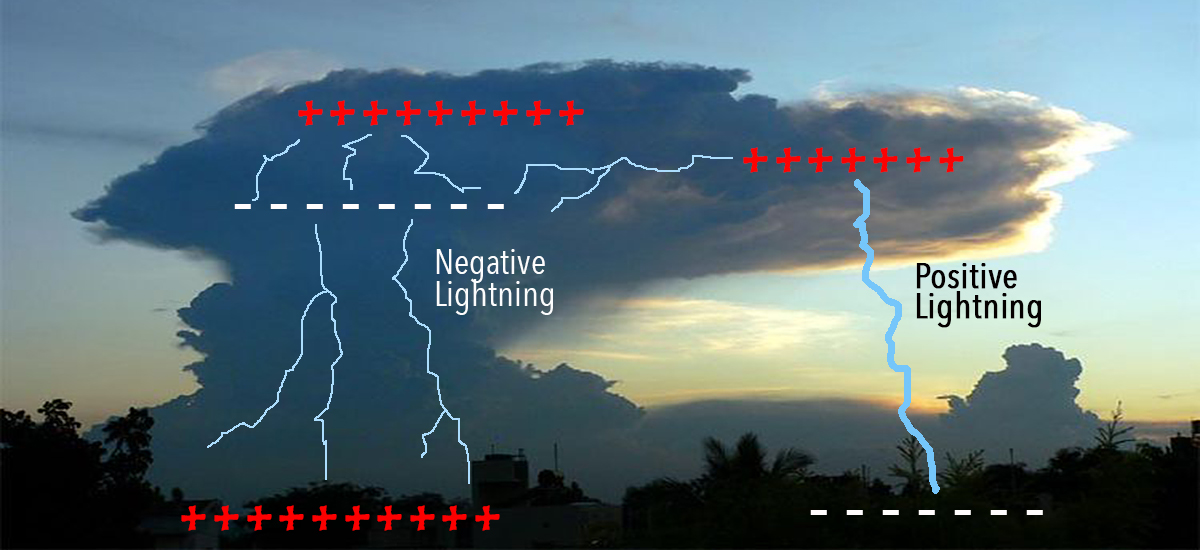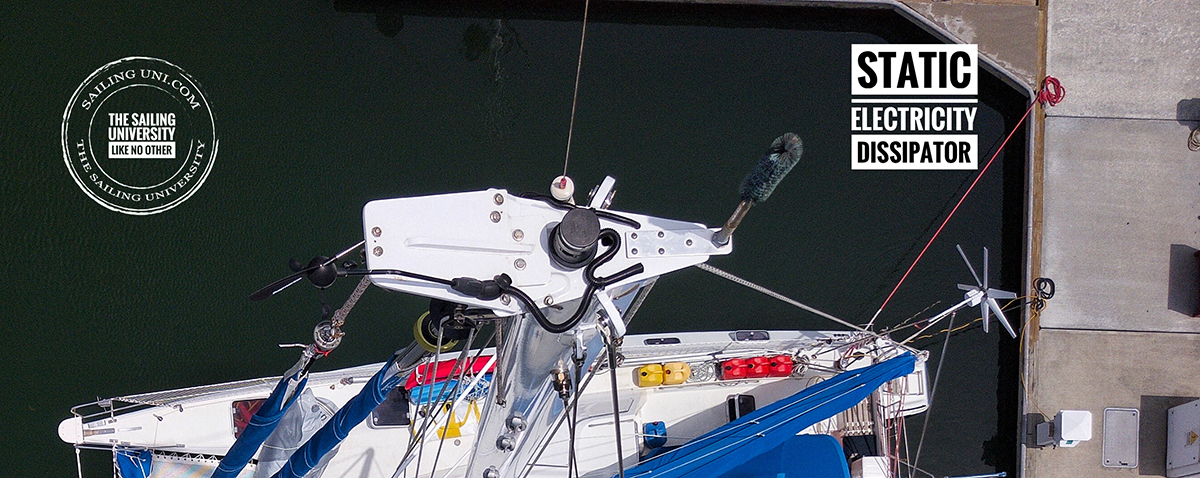

NEGATIVE LIGHTNING IS BAD - POSITIVE LIGHTNING IS BAD TO THE BONE
No all lightning is created equal.
Negative lightning is bad, but positive lightning is even worse. It's bad to the bone.
Negative lightning constitutes 90-95% of the lightning strikes and typically has 300,000,000 volts and 30,000 amps.
Positive lightning constitutes 5-10% of lightning strikes and typically has 1,000,000,000 volts and 300,000 amps. A positive lightning bolt last ten times longer than a negative one, and positive lightning is ten times more powerful than its negative counterpart.
You need to avoid positive lightning at all costs, and if you can't avoid a thunderstorm, you should at least avoid those areas around a thunderstorm where you are at the greatest risk.
Cumulonimbus clouds are never your friends, and the further you stay away from them, the better your life will be.
Strong updrafts in cumulonimbus clouds move positively charged particles to the top of the cloud, and negatively charged particles accumulate at the base of the clouds. No one knows exactly how and why these charges form, but that is what happens.
As the charges build up, it creates an electric field between the positive and negative regions of the cloud, and when the charge reaches a critical level, a lightning bolt happens which collapses the electric field until the charge builds up again, and another lightning bolt occurs.
Large thunderstorms produce more lightning than small thunderstorms.
Massive cumulonimbus clouds have stronger updrafts that move more positively charged particles to the top of the cloud, and consequently, more lightning strikes are likely to happen with large clouds.
Smaller cumulonimbus clouds have weaker updrafts and as a result produce less lightning.
When lightning discharges within a cloud, it's called intra-cloud lightning, and this makes up the majority of the lightning you see when sailing offshore.
The negative base of a thunderstorm induces an opposite positive charge in the ground, and if the electrical potential becomes high enough for a leader to occur, a cloud to ground lightning strike happens.
In a typical thunderstorm, 75% of the lightning is intra-cloud lightning. 20% of the lightning is cloud to ground, and 5% of the lightning is positive.
In negative lightning, negative electrons flow in the lightning bolt. In positive lightning, positive charge flows instead of electrons.
Positive lightning is more common at the peak of a severe thunderstorm and as the thunderstorm dissipates.
Positive Lightning tends to originate at high altitude (30,000 - 60,000 feet) from the overhanging anvil at the top of a cumulonimbus cloud where the positive charge is greatest.
Positive lightning bolts may strike more than thirty miles away from the base of the storm, and when a bolt out of the blue happens, it's likely positive lightning.
Positive lightning usually occurs as a single massive finger coming down from the cloud without significant branching.
Most of the time, the ground is shielded from the high altitude positive charge by negative charges in the base of the storm. But when you have strong upper level winds pushing the top of the cloud out in front of the storm creating an anvil configuration, the positive charge gets displaced in front of the body of the storm, and there is nothing to shield the ground from a massive high altitude positive lightning strike.
When the electrical potential difference between the upper level positive charge and the negative charge on the ground becomes great enough, a positive leader comes down from the cloud initiating the lightning strike.
Because a positive lightning bolt has to travel such a great distance, it has to be ten times stronger to make the trip, and it lasts ten times as long. Consequently the damage created by positive lightning is usually far greater than a negative strike.
A billion volts and 300,000 amps can do a lot of damage, and the fact that the strike lasts ten times longer gives the lightning more time and power to create damage.
Positive strikes start forest fires, set buildings on fire and shut down the electrical grid.
Your chance of survival is much less if you are struck by a positive bolt compared to a negative one. Fortunately, most strikes are negative which significantly increase your chance of survival.
Positive strikes are a problem because they can occur up to thirty miles away from the thunderstorm. The storm is so far away, you cannot hear its thunder, and you would not know it was there unless it was happening at night and you could see the lightning in the far distance.
What are the practical implications for the sailor?
1. Do everything you can to stay away from thunderstorms.
Whenever I encounter a thunderstorm, I monitor the storm on radar putting an estimated bearing line on the cumulonimbus cloud. If the storms comes down my estimated bearing line, I alter course to stay far away from the offending cloud. Sometimes that means I alter my course by 90 degrees, and if the storm is particularly severe, I may reverse my course by 180 degrees and wait several hours for the storm to pass. I know that sounds inconvenient, but getting struck by lightning is even more incovenient and very expensive to repair the damage caused to the yacht.
2. Do everything in your power to stay away from the overhanging anvil on the edge of a cumulonimbus cloud. Beneath the anvil you have no shield from the positive charge at the top of the cumulonimbus cloud, and that is where you have the greatest risk of being struck by a positive bolt.
3. When you see lightning and you hear thunder within five seconds, the lightning is just a mile away. If it is less than five seconds, the lightning is very close. Don't travel in your dingy or stand under palm trees when lightning is so near.
4. If a thunderstorm is twenty miles away, and you get struck by a bolt out of the blue, it was just your time to go. There's nothing you can do to prevent it from happening unless you want to live inside a faraday cage.
Our experience with lightning on board Exit Only has mainly been one of avoidance.
Twenty-five years ago, we had "ball lightning" come down our mast in Fort Lauderdale. My wife heard a clap of thunder, and when she looked up the mast, she saw "ball lightning" come down to the level of the boom, and then the ball shot back up the mast. I don't know if that represented a lightning strike, and lightning researchers don't know either. The "ball lightning" did no harm - it was just an interesting curiosity that has not happened again. The ball is apparently a plasma of ionized air that occurs in a highly charged environment. It's not a lightning strike in the classic sense.

Before we left on our circumnavigation, I installed a twelve inch long bronze bottle brush static electricity dissipator on the top of our mast. The company selling the dissipator agreed to pay the first thousand dollars in damage if a lightning strike occurred. In twenty-five years, we never had a direct strike, so maybe the static dissipator actually works. That company no longer is in business.
Whenever we are in a powerful thunderstorm at anchor, I attach twenty foot jumper cables to the mast and rigging, and I drop the ends of the jumper cables in the water. I don't know if it does any good, but I do it anyway. When Exit Only arrived in Singapore during our circumnavigation, five yachts were struck by lightning within a period of one week. It was the beginning of monsoon season, and the lightning was fierce. I used the jumper cables all the time in Singapore, and we had no lightning strikes. All five yachts struck by lightning were monohulls, and we are a catamaran - interesting - since multihulls are struck more frequently than monohulls.
When we sailed through the Windward Passage between Cuba and Haiti, we experienced intense lightning off the coast of Haiti at night. Exit Only did its usual lightning dance to avoid the worst of the lightning. We turned on our radar to follow the storms and altered course as necessary. When we needed to speed up to stay out of harms way, we ran one engine or two. We even turned around and headed 180 degrees from our desired course to avoid the most powerful storms. Such is the life of those who do the lightning ballet.
Stay tuned for more reports as were are once again sailing around the world.
Awesome music video that captures the essence of what it's like to sail offshore in a catamaran around the world when conditions are less than perfect. David Abbott from Too Many Drummers sings the vocals, and he also edited the footage from our Red Sea adventures. This is the theme song from the Red Sea Chronicles.
Sailing up the Red Sea is not for the faint of heart. From the Bab al Mandeb to the Suez Canal, adventures and adversity are in abundance. If you take things too seriously, you just might get the Red Sea Blues.
If you like drum beats, and you like adventure, then have a listen to the Red Sea Chronicles Trailer.
Flying fish assault Exit Only in the middle of the night as we sail through the Arabian Gulf from the Maldives to Oman. And so begins our Red Sea adventures.
Sailing through Pirate Alley between Yemen and Somalia involves calculated risk. It may not be Russian Roulette, but it is a bit of a worry. Follow Team Maxing Out as they navigate through Pirate Alley.
Stopping in Yemen was just what the doctor ordered. We refueled, repaired our alternator, and we made friends with our gracious Yemeni hosts. We also went to Baskins Robbins as a reward for surviving Pirate Alley.
After you survive Pirate Alley, you must sail through the Gate of Sorrows (Bab Al Mandab) at the southern entrance to the Red Sea. The Gate of Sorrows lived up to its name with fifty knots of wind and a sandstorm that pummeled Exit Only for two days. Life is good.
Although I like the feel of a paper book in my hand, I love trees even more. When people purchase an eBook, they actually save trees and save money as well. Ebooks are less expensive and have no negative impact on the environment. All of Dr. Dave's books are available at Save A Tree Bookstore. Visit the bookstore today and start putting good things into your mind. It's easy to fill your mind with positive things using eBooks. No matter where you are or what you are doing, you can pull out your smart phone or tablet and start reading. You can even use electronic highlighters and make annotations in your eBooks just like paper books.